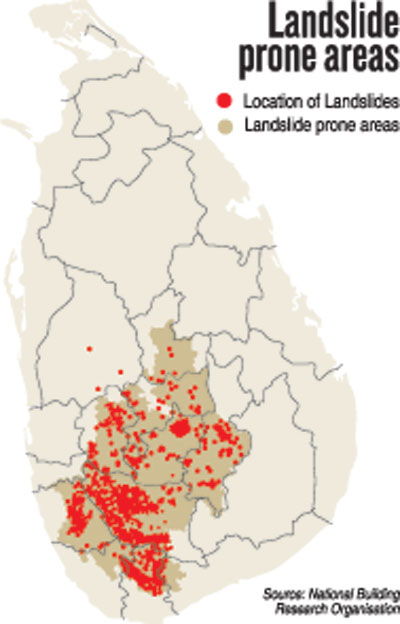News
Downpours displace thousands, landslide dangers unabated
Landslide warnings in the Nuwara Eliya, Matale, Kandy, Ratnapura and Badulla Districts are still effective due to the prevailing turbulent weather, said the National Building Research Organization (NBRO).
Residents of Walapane divisional secretariat in Nuwara Eliya, Gangawata Korale and Udunuwara divisional secretariats of Kandy, Ukuwela divisional secretariat of Matale, Ratnapura, Elapatha, Pelmadulla and Nivithigala divisional secretariats of Ratnapura and Passara, and Lunugala divisional secretariats of Badulla have been warned about landslides.
Dr. Gamini Jayathissa, acting director of landslide research and risk management division of the NBRO told the Sunday Times that a new circular had been issued by the Ministry of Disaster Management stating that the compulsory approval of the NBRO is required to prevent haphazard developments. Since 2011, the NBRO has been streamlining construction and development to encourage proper land use. Despite the new circular, non-compliant construction has continued.
“With the bad experiences in the past, people have understood the gravity of landslides as a result of which some of them come forward to seek the approval of the NBRO,’’ he said. According to him, generally, rainfall is a trigger factor for landslides, and terrain factors like soil thickness, slope angle, soil type and geological structure of the area combine to create instability in slopes.
“Landslides are most prevalent in May during the southwest monsoon and during the transition period from the second inter-monsoon to the northeast monsoon.”
According to a report by the DMC, as of 12:00 hours on Friday, 17,873 people from 4,634 families have been badly affected by the heavy rainfall. Further, 34 houses were fully damaged while 1,018 houses were partially damaged. Meanwhile, two people were injured by lightning in the Batticaloa District.
Project director, landslide disaster protection project of the National Road Network (NRN), Kapila Kodituwakku, said that there are more slope failures than landslides in Sri Lanka and if a slope is found to be weak, it will be strengthened with concrete structures
“When roads were built on slopes, attention was never given to protecting the slope, which has now resulted in slope failures and breakdown of slopes.”
The Road Development Authority (RDA) has sought to adopt a mechanism where the road contractors will draw estimates for slope protection construction methods when building roads.
According to him, an estimated Rs.10,000 to 20,000 will be spent per square metre. He added that there are also slope protection construction methods such as growing plants on slopes to reduce erosion and cracks. District Secretary of Kandy and Kegalle, L.J.M.G. Chandrasiri Bandara said that 60% of the land in the Kegalle district is tensile, including some areas in the Kandy district as a result of which landslides can occur.
“Around 1,600 houses have been built for people in high-risk areas. There are also about 200 families who have handed affidavits stating that they are voluntarily living in landslide risk areas.”
District Secretary of Nuwara Eliya, M.B.R. Pushpakumara said that officials have been informed of the high-risk areas and their leave has been cancelled.
“When there is a heavy rain, the residents are aware of the evacuation process after experiencing such situations in the past.”
Forecasting director of the Department of Meteorology, Anusha Warnasooriya told the Sunday Times that rough weather will prevail until the end of November.
According to her, most parts of the island will experience rain during the evenings, while East, North Central, North and Uva Provinces will receive rainfall throughout the day. “Drought stricken areas have received considerable rains in the past couple of days.”
She said that in October and November Sri Lanka receives 30% of its annual rainfall.
Deputy director and media spokesman of the DMC, Pradeep Kodippili said that during an emergency of a spill from a reservoir, a team of tri-forces and police at the DMC is notified, following which, they will be deployed to the respective areas to evacuate people.
“Area police will also be informed of the situation as a result of which the vulnerable community will be informed of the forecast and and evacuation will take place,’’ he said.
According to the DMC, spill gates of the following reservoirs have been open since Thursday — Kotmale, Inginimitiya, Rajanganaya, Deduru Oya, Kukule Ganga, Udawalawe and Victoria. Meanwhile, spill gates of Tabbowa and Nachchaduwa tanks have also been opened.
Mr. Kodippili said that a warning has been issued to the residents to stay away from the Mahaweli River.
Director of development and media spokesman to the Ministry of Power and Renewable Energy, Sulakshana Jayawardena, told the Sunday Times that, as of Friday, the average of the main six reservoirs amounted to 89.9%.
He added that the Castlereagh reservoir had an average of 91.9%, Maussakelle reservoir with an average of 83.4%, Kotmale reservoir amounted to 98.2%, Victoria reservoir 100%, Randenigala reservoir 96.6% and Samanalawewa 53.3%.
“With the heavy rains, the daily demands reduce as a result of which the present daily demand is around 37 to 38-gigawatt hours, whereas during the dry zone the daily demands shot up to a record-breaking 45-gigawatt hours during April and March.”
W.M.D. Wanninayake, media director at the Ministry of Agriculture told the Sunday Times that if the heavy rains continue after the rice plants have grown, they could suffer damage.
However, he said the prevailing weather is ideal to begin Maha season cultivation and there is hope of an improved harvest.
According to him, 15 to 20 acres of big onions were destroyed due to the bad weather and officers have been sent to assess the situation and arrange compensation payments.

